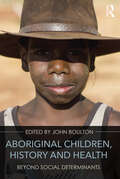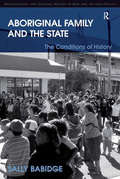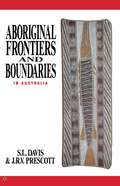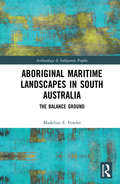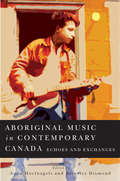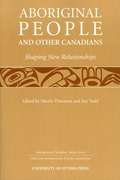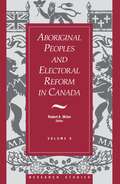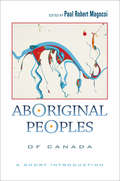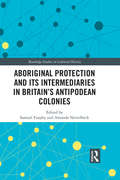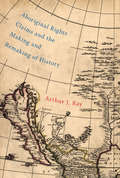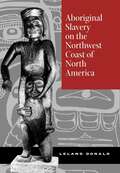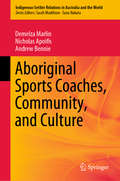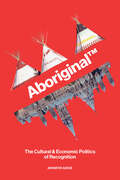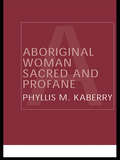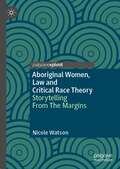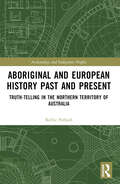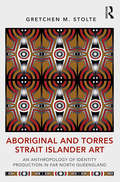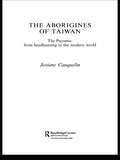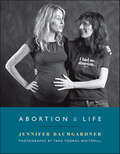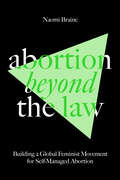- Table View
- List View
Aboriginal Children, History and Health: Beyond Social Determinants
by John BoultonThis volume traces the complex reasons behind the disturbing discrepancy between the health and well-being of children in mainstream Australia and those in remote Indigenous communities. Invaluably informed by Boulton’s close working knowledge of Aboriginal communities, the book addresses growth faltering as a crisis of Aboriginal parenting and a continued problem for the Australian nation. The high rate and root causes of ill-health amongst Aboriginal children are explored through a unique synthesis of historical, anthropological, biological and medical analyses. Through this fresh approach, which includes the insights of specialists from a range of disciplines, Aboriginal Children, History and Health provides a thoughtful and innovative framework for considering Indigenous health.
Aboriginal Family and the State: The Conditions of History (Anthropology and Cultural History in Asia and the Indo-Pacific)
by Sally BabidgeAboriginal Family and the State examines the contemporary relations and history of Indigenous families in Australia, specifically referencing issues of government control and recent official recognition of Aboriginal 'traditional owners'. Drawing on detailed empirical research, it develops a discussion of the anthropological issues of kinship and relatedness within colonial and 'postcolonial' contexts. This volume explores the conditions affecting the formation of 'family' among indigenous people in rural northern Australia, as well as the contingencies of 'family' in the legal and political context of contemporary indigenous claims to land. With a rich discussion of the production, practice and inscription of social relations, this volume examines everyday expressions of 'family', and events such as meetings and funerals, demonstrating that kinship is formed and reformed through a complicated social practice of competing demands on identity.
Aboriginal Frontiers And Boundaries In Australia
by J. R. Prescott S. L. DavisBefore the coming of Europeans, Aboriginal communities lived within territories defined by complex ritual cycles of song, dance, symbol and ceremony. Knowledge of these boundaries and frontiers was in the keeping of senior custodians. In traditional communities, this continues to be the situation. Today, white Australians belatedly acknowledge Aboriginal land rights and the special significance of sacred sites. This makes an understanding of the boundaries vital to the achievement of basic land and sea rights for Aboriginal people. Unfortunately, over much of the continent, knowledge of boundaries has been lost or is in danger of being lost. In this work two political geographers explore the nature of Aboriginal boundaries and their contemporary implications. In four detailed case studies they challenge many of the assumptions which have underpinned the involvement of white advisers. The result is a timely study which raises important questions about an issue of national significance.
Aboriginal Health in Canada
by D. Ann Herring James Waldram T. Kue YoungNumerous studies, inquiries, and statistics accumulated over the years have demonstrated the poor health status of Aboriginal peoples relative to the Canadian population in general. Aboriginal Health in Canada is about the complex web of physiological, psychological, spiritual, historical, sociological, cultural, economic, and environmental factors that contribute to health and disease patterns among the Aboriginal peoples of Canada. The authors explore the evidence for changes in patterns of health and disease prior to and since European contact, up to the present. They discuss medical systems and the place of medicine within various Aboriginal cultures and trace the relationship between politics and the organization of health services for Aboriginal people. They also examine popular explanations for Aboriginal health patterns today, and emphasize the need to understand both the historical-cultural context of health issues, as well as the circumstances that give rise to variation in health problems and healing strategies in Aboriginal communities across the country. An overview of Aboriginal peoples in Canada provides a very general background for the non-specialist. Finally, contemporary Aboriginal healing traditions, the issue of self-determination and health care, and current trends in Aboriginal health issues are examined.
Aboriginal Maritime Landscapes in South Australia: The Balance Ground (Archaeology & Indigenous Peoples)
by Madeline E. FowlerAboriginal Maritime Landscapes in South Australia reveals the maritime landscape of a coastal Aboriginal mission, Burgiyana (Point Pearce), in South Australia, based on the experiences of the Narungga community. A collaborative initiative with Narungga peoples and a cross-disciplinary approach have resulted in new understandings of the maritime history of Australia. Analysis of the long-term participation of Narungga peoples in Australia’s maritime past, informed by Narungga oral histories, primary archival research and archaeological fieldwork, delivers insights into the world of Aboriginal peoples in the post-contact maritime landscape. This demonstrates that multiple interpretations of Australia’s maritime past exist and provokes a reconsideration of how the relationship between maritime and Indigenous archaeology is seen. This book describes the balance ground shaped through the collaboration, collision and reconciliation of Aboriginal and non-Aboriginal peoples in Australia. It considers community-based practices, cohesively recording such areas of importance to Aboriginal communities as beliefs, knowledges and lived experiences through a maritime lens, highlighting the presence of Narungga and Burgiyana peoples in a heretofore Western-dominated maritime literature. Through its consideration of such themes as maritime archaeology and Aboriginal history, the book is of value to scholars in a broad range of disciplines, including archaeology, anthropology, history and Indigenous studies.
Aboriginal Music in Contemporary Canada: Echoes and Exchanges
by Anna Hoefnagels Beverley DiamondFirst Nations, Inuit, and Métis music in Canada is dynamic and diverse, reflecting continuities with earlier traditions and innovative approaches to creating new musical sounds. Aboriginal Music in Contemporary Canada narrates a story of resistance and renewal, struggle and success, as indigenous musicians in Canada negotiate who they are and who they want to be. Comprised of essays, interviews, and personal reflections by Aboriginal and non-Aboriginal musicians and scholars alike, the collection highlights themes of innovation, teaching and transmission, and cultural interaction. Individual chapters discuss musical genres ranging from popular styles including country and pop to nation-specific and intertribal practices such as powwows, as well as hybrid performances that incorporate music with theatre and dance. As a whole, this collection demonstrates how music is a powerful tool for articulating the social challenges faced by Aboriginal communities and an effective way to affirm indigenous strength and pride. Juxtaposing scholarly study with artistic practice, Aboriginal Music in Contemporary Canada celebrates and critically engages Canada's vibrant Aboriginal music scene. Contributors include Véronique Audet (Université de Montreal), Columpa C. Bobb (Tsleil Waututh and Nlaka'pamux, Manitoba Theatre for Young People), Sadie Buck (Haudenosaunee), Annette Chrétien (Métis), Marie Clements (Métis/Dene), Walter Denny Jr. (Mi'kmaw), Gabriel Desrosiers (Ojibwa, University of Minnesota, Morris), Beverley Diamond (Memorial University), Jimmy Dick (Cree), Byron Dueck (Royal Northern College of Music), Klisala Harrison (University of Helsinki), Donna Lariviere (Algonquin), Charity Marsh (University of Regina), Sophie Merasty (Dene and Cree), Garry Oker (Dane-zaa), Marcia Ostashewski (Cape Breton University), Mary Piercey (Memorial University), Amber Ridington (Memorial University), Dylan Robinson (Stó:lo, University of Toronto), Christopher Scales (Michigan State University), Gilles Sioui (Wendat), Gordon E. Smith (Queen's University), Beverly Souliere (Algonquin), Janice Esther Tulk (Memorial University), Florent Vollant (Innu) and Russell Wallace (Lil'wat).
Aboriginal Music in Contemporary: Echoes and Exchanges (McGill-Queen's Indigenous and Northern Studies)
by Anna Hoefnagels Beverley DiamondFirst Nations, Inuit, and Métis music in Canada is dynamic and diverse, reflecting continuities with earlier traditions and innovative approaches to creating new musical sounds. Aboriginal Music in Contemporary Canada narrates a story of resistance and renewal, struggle and success, as indigenous musicians in Canada negotiate who they are and who they want to be. Comprised of essays, interviews, and personal reflections by Aboriginal and non-Aboriginal musicians and scholars alike, the collection highlights themes of innovation, teaching and transmission, and cultural interaction. Individual chapters discuss musical genres ranging from popular styles including country and pop to nation-specific and intertribal practices such as powwows, as well as hybrid performances that incorporate music with theatre and dance. As a whole, this collection demonstrates how music is a powerful tool for articulating the social challenges faced by Aboriginal communities and an effective way to affirm indigenous strength and pride. Juxtaposing scholarly study with artistic practice, Aboriginal Music in Contemporary Canada celebrates and critically engages Canada's vibrant Aboriginal music scene. Contributors include Véronique Audet (Université de Montreal), Columpa C. Bobb (Tsleil Waututh and Nlaka'pamux, Manitoba Theatre for Young People), Sadie Buck (Haudenosaunee), Annette Chrétien (Métis), Marie Clements (Métis/Dene), Walter Denny Jr. (Mi'kmaw), Gabriel Desrosiers (Ojibwa, University of Minnesota, Morris), Beverley Diamond (Memorial University), Jimmy Dick (Cree), Byron Dueck (Royal Northern College of Music), Klisala Harrison (University of Helsinki), Donna Lariviere (Algonquin), Charity Marsh (University of Regina), Sophie Merasty (Dene and Cree), Garry Oker (Dane-zaa), Marcia Ostashewski (Cape Breton University), Mary Piercey (Memorial University), Amber Ridington (Memorial University), Dylan Robinson (Stó:lo, University of Toronto), Christopher Scales (Michigan State University), Gilles Sioui (Wendat), Gordon E. Smith (Queen's University), Beverly Souliere (Algonquin), Janice Esther Tulk (Memorial University), Florent Vollant (Innu) and Russell Wallace (Lil'wat).
Aboriginal People and Colonizers of Western Canada to 1900
by Sarah Alexander CarterThe history of Canada's Aboriginal peoples after European contact is a hotly debated area of study. In Aboriginal People and Colonizers of Western Canada to 1900, Sarah Carter looks at the cultural, political, and economic issues of this contested history, focusing on the western interior, or what would later become Canada's prairie provinces.This wide-ranging survey draws on the wealth of interdisciplinary scholarship of the last three decades. Topics include the impact of European diseases, changing interpretations of fur trade interaction, the Red River settlement as a cultural crossroad, missionaries, treaties, the disappearance of the buffalo, the myths about the Mounties, Canadian 'Indian' policy, and the policies of Aboriginal peoples towards Canada.Carter focuses on the multiplicity of perspectives that exist on past events. Referring to nearly all of the current scholarship in the field, she presents opposing versions on every major topic, often linking these debates to contemporary issues. The result is a sensitive treatment of history as an interpretive exercise, making this an invaluable text for students as well as all those interested in Aboriginal/Non-Aboriginal relations.
Aboriginal People and Other Canadians: Shaping New Relationships
by Martin Thornton Roy ToddThis book discusses a wide variety of issues in Native studies including social exclusion, marginalization and identity; justice, equality and gender; self-help and empowerment in Aboriginal communities and in the cities; and, methodological and historiographical representations of social relationships.
Aboriginal Peoples and Electoral Reform in Canada: Volume 9
by Robert A. MilenThis volume features differing views of past, present, and possible future roles for Aboriginal people in the Canadian political and electoral system. The studies address the issues facing Aboriginal people and the efforts to increase their involvement in the federal electoral system. Robert Milen examines the development of Aboriginal political consciousness since the 1970s, with attention to recent constitutional and electoral initiatives and aspirations. Augie Fleras’ study considers the New Zealand system of guaranteed representation for the Maori and suggests how Canada might follow this example. Valerie Alia studies how the media deal with Aboriginal issues, basing her recommendations on interviews with Aboriginal people who offered her their views. Roger Gibbins critiques the idea of guaranteed Aboriginal representation in the House of Commons.
Aboriginal Peoples of Canada
by Paul Robert MagocsiCanada's Aboriginal Peoples: A Short Introduction fills a previously overlooked gap by providing the first comprehensive overview of Canada's First Nations people. Drawn from the highly successful Encyclopedia of Canada's Peoples it offers extensive coverage of Canada's aboriginal peoples, including the Algonquians/Eastern Woodlands, Algonquians/Plains, Algonquians/Subarctic, Inuit, Iroquoians, Ktunaxa, Metis, Na-Dene, Salish, Siouan, Tsimshian, and Wakashans, as well as the many nations within these larger groupings.With a new preface by Paul Robert Magocsi and an introduction by well-known historian Jim Miller, the collection has papers on each main group written by such scholars as Janet Chute, Olive Dickason, Louis-Jacques Dorais, and Eldon Yellowhorn. Each essay covers economics, culture, language, education, politics, kinship, religion, social organization, identification, and history of each nation, among other topics, and ends with suggestions for further readings. Readable and suitable for the student, casual reader or expert, the book is an excellent introduction to Canada's aboriginal peoples.
Aboriginal Protection and Its Intermediaries in Britain’s Antipodean Colonies (Routledge Studies in Cultural History #74)
by Amanda Nettelbeck Samuel FurphyThis collection brings together world-leading and emerging scholars to explore how the concept of "protection" was applied to Indigenous peoples of Britain’s antipodean colonies. Tracing evolutions in protection from the 1830s until the end of the nineteenth century, the contributors map the changes and continuities that marked it as an inherently ambivalent mode of colonial practice. In doing so, they consider the place of different historical actors who were involved in the implementation of protective policy, who served as its intermediaries on the ground, or who responded as its intended "beneficiaries." These included metropolitan and colonial administrators, Protectors or similar agents, government interpreters and church-affiliated missionaries, settlers with economic investments in the politics of conciliation, and the Indigenous peoples who were themselves subjected to colonial policies. Drawing out some of the interventions and encounters lived out in the name of protection, the book examines some of the critical roles it played in the making of colonial relations.
Aboriginal Rights Claims and the Making and Remaking of History
by Arthur J. RayForums such as commissions, courtroom trials, and tribunals that have been established through the second half of the twentieth century to address Aboriginal land claims have consequently created a particular way of presenting Aboriginal, colonial, and national histories. The history that emerges from these land-claims processes is often criticized for being "presentist" - inaccurately interpreting historical actions and actors through the lens of present-day values, practices, and concerns. In Aboriginal Rights Claims and the Making and Remaking of History, Arthur Ray examines how claims-oriented research is often fitted to the existing frames of Indigenous rights law and claims legislation and, as a result, has influenced the development of these laws and legislation. Through a comparative study encompassing Australia, Canada, New Zealand, South Africa, and the United States, Ray also explores the ways in which various procedures and settings for claims adjudication have influenced and changed the use of historical evidence, made space for Indigenous voices, stimulated scholarly debates about the cultural and historical experiences of Indigenous peoples at the time of initial European contact and afterward, and have provoked reactions from politicians and scholars. While giving serious consideration to the flaws and strengths of presentist histories, Aboriginal Rights Claims and the Making and Remaking of History provides Aboriginal, academic, and legal communities with essential information on how history is used and how methods are adapted and changed.
Aboriginal Rights Claims and the Making and Remaking of History (McGill-Queen's Indigenous and Northern Studies #87)
by Arthur J. RayForums such as commissions, courtroom trials, and tribunals that have been established through the second half of the twentieth century to address aboriginal land claims have consequently created a particular way of presenting aboriginal, colonial, and national histories. The history that emerges from these land-claims processes is often criticized for being “presentist” – inaccurately interpreting historical actions and actors through the lens of present-day values, practices, and concerns. In Aboriginal Rights Claims and the Making and Remaking of History, Arthur Ray examines how claims-oriented research is often fitted to the existing frames of indigenous rights law and claims legislation and, as a result, has influenced the development of these laws and legislation. Through a comparative study encompassing the United States, Canada, South Africa, Australia and New Zealand, Ray also explores the ways in which various procedures and settings for claims adjudication have influenced and changed the use of historical evidence, made space for indigenous voices, stimulated scholarly debates about the cultural and historical experiences of indigenous peoples at the time of initial European contact and afterward, and have provoked reactions from politicians and scholars. While giving serious consideration to the flaws and strengths of presentist histories, Aboriginal Rights Claims and the Making and Remaking of History provides communities with essential information on how history is used and how methods are adapted and changed.
Aboriginal Slavery on the Northwest Coast of North America
by Leland DonaldWith his investigation of slavery on the Northwest Coast of North America, Leland Donald makes a significant contribution to our understanding of the aboriginal cultures of this area. He shows that Northwest Coast servitude, relatively neglected by researchers in the past, fits an appropriate cross-cultural definition of slavery. Arguing that slaves and slavery were central to these hunting-fishing-gathering societies, he points out how important slaves were to the Northwest Coast economies for their labor and for their value as major items of exchange. Slavery also played a major role in more famous and frequently analyzed Northwest Coast cultural forms such as the potlatch and the spectacular art style and ritual systems of elite groups.The book includes detailed chapters on who owned slaves and the relations between masters and slaves; how slaves were procured; transactions in slaves; the nature, use, and value of slave labor; and the role of slaves in rituals. In addition to analyzing all the available data, ethnographic and historic, on slavery in traditional Northwest Coast cultures, Donald compares the status of Northwest Coast slaves with that of war captives in other parts of traditional Native North America.
Aboriginal Sports Coaches, Community, and Culture (Indigenous-Settler Relations in Australia and the World #2)
by Nicholas Apoifis Demelza Marlin Andrew BennieThis book is the first to celebrate the stories of this group of Aboriginal mentors and leaders and present them in a form that is accessible to both academic and general audiences. In this book, Aboriginal sport coaches from all over Australia share stories about their involvement in sport and community, offering insight into the diverse experiences of Aboriginal people in settler colonial Australia. This collection amplifies the public voice of Aboriginal coaches who are transforming the social, cultural, and political lives of Aboriginal and non-Aboriginal people. These stories have been overlooked in public discussion about sport and indigeneity. Frank and often funny, these intimate narratives provide insight into the unique experiences and attitudes of this group of coaches. This book deepens our understanding of the shared and contested history of Aboriginal peoples’ engagement with sport in Australia.
Aboriginal TM: The Cultural and Economic Politics of Recognition
by Jennifer AdeseIn Aboriginal™, Jennifer Adese explores the origins, meaning, and usage of the term “Aboriginal” and its displacement by the word “Indigenous.” In the Constitution Act, 1982, the term’s express purpose was to speak to specific “aboriginal rights”. Yet in the wake of the Constitution’s passage, Aboriginal, in its capitalized form, became increasingly used to describe and categorize people. More than simple legal and political vernacular, the term Aboriginal (capitalized or not) has had real-world consequences for the people it defined. Aboriginal™ argues the term was a tool used to advance Canada’s cultural and economic assimilatory agenda throughout the 1980s until the mid-2010s. Moreover, Adese illuminates how the word engenders a kind of “Aboriginalized multicultural” brand easily reduced to and exported as a nation brand, economic brand, and place brand—at odds with the diversity and complexity of Indigenous peoples and communities. In her multi-disciplinary research, Adese examines the discursive spaces and concrete sites where Aboriginality features prominently: the Constitution Act, 1982; the 2010 Vancouver Olympics; the “Aboriginal tourism industry”; and the Vancouver International Airport. Reflecting on the term’s abrupt exit from public discourse and the recent turn toward Indigenous, Indigeneity, and Indigenization, Aboriginal™ offers insight into Indigenous-Canada relations, reconciliation efforts, and current discussions of Indigenous identity, authenticity, and agency.
Aboriginal Woman Sacred and Profane
by Phyllis KaberryFirst published in 1939 by Routledge, this classic ethnography portrays the aboriginal woman as she really is - a complex social personality with her own prerogatives, duties, problems, beliefs, rituals and point of view. This groundbreaking and enduring study was researched in North-West Australia between 1935 and 1936 and was written by a woman who truly pioneered the study of gender in anthropology
Aboriginal Women, Law and Critical Race Theory: Storytelling From The Margins (Palgrave Studies in Race, Ethnicity, Indigeneity and Criminal Justice)
by Nicole WatsonThis book explores storytelling as an innovative means of improving understanding of Indigenous people and their histories and struggles including with the law. It uses the Critical Race Theory (‘CRT’) tool of ‘outsider’ or ‘counter’ storytelling to illuminate the practices that have been used by generations of Aboriginal women to create an outlaw culture and to resist their invisibility to law. Legal scholars are yet to use storytelling to bring the experiential knowledge of Aboriginal women to the centre of legal scholarship and yet this book demonstrates how this can be done by way of a new methodology that combines elements of CRT with speculative biography. In one chapter, the author tells the imagined story of Eliza Woree who featured prominently in the backdrop to the decision of the Supreme Court of Queensland in Dempsey v Rigg (1914) but whose voice was erased from the judgements. This accessible book adds a new and innovative dimension to the use of CRT to examine the nexus between race and settler colonialism. It speaks to those interested in Indigenous peoples and the law, Indigenous studies, Indigenous policy, Aboriginal and Torres Strait Islander history, feminist studies, race and the law, and cultural studies.
Aboriginal and European History Past and Present: Truth-telling in the Northern Territory of Australia (Archaeology and Indigenous Peoples)
by Kellie PollardThis book analyses the 150-year history of continuous contact between Aboriginal people and non-Aboriginal people in the Darwin region of the Northern Territory of Australia after the European invasion in 1869 to the present day.It explores the role Aboriginal fringe camps served, and still do, as places of interface between Aboriginal people and non-Aboriginal people in the context of ongoing colonialism after colonisation. The book argues that Aboriginal fringe camps provide much potential for elucidating aspects of Aboriginal responses to the European invasion and, in a contemporary context, bear distinct evidence of a cultural nature that associates their origins, use, purpose, and functions predominantly with Aboriginal people. It contributes a new and innovative theoretical model that will enable readers to conceive how insights about Aboriginal behaviour in the context of Aboriginal fringe camps were achieved. The model is informed by the frameworks of colonialism and, innovatively, philosophy.Contributing new theoretical knowledge to contact histories and relations between Europeans and Indigenous peoples, the book will be important to researchers in the archaeology of Australia and those concerned with Indigenous Studies.
Aboriginal and Torres Strait Islander Art: An Anthropology of Identity Production in Far North Queensland (Criminal Practice Ser.)
by Gretchen M. StolteAboriginal and Torres Strait Islander Art explores the effects of Queensland government policies on urban First Nation artists. While such art has often been misinterpreted as derivative lesser copies of ‘true’ Indigenous works, this book unveils new histories and understandings about the mixed legacy left for Queensland Indigenous artists. Gretchen Stolte uses rich ethnographic detail to illuminate how both Aboriginal and Torres Strait Islander artists understand and express their heritage. She specifically focuses on artwork at the Aboriginal and Torres Strait Islander art studio in the Tropical North Queensland College of Technical and Further Education (TNQT TAFE), Cairns. Stolte's ethnography further develops methodologies in art history and anthropology by identifying additional methods for understanding how art is produced and meaning is created.
Aboriginal and Torres Strait Islander Education
by Kaye PriceAboriginal and Torres Strait Islander Education: An Introduction for the Teaching Profession prepares students for the classroom and community environments they will encounter when teaching Aboriginal and Torres Strait Islander children in urban, rural and remote schools at early childhood, primary and secondary levels. The book addresses many issues and challenges faced by teacher education students and assists them to understand the deeper social, cultural and historical context of Aboriginal and Torres Strait Islander education. This is a unique textbook written by a team of highly regarded Aboriginal and Torres Strait Islander academics. Each chapter opens with an engaging anecdote from the author, connecting learning to real-world issues. This is also the first textbook to address Torres Strait Islander education. Written in an engaging and accessible style, Aboriginal and Torres Strait Islander Education is an essential resource for teacher education students.
Aborigines of Taiwan: The Puyuma: From Headhunting to the Modern World
by Josiane CauquelinBased on extensive field research over a period of twenty years, this is the first comprehensive study of the Puyuma people of Taiwan. The Puyuma belong to the Austronesian peoples, which today number less than 370,000. In Taiwan, they are the least known of the aboriginal groups, numbering only 6000, and inhabiting the Southeastern province of Taitung. The study looks at the historical changes in the status and definition of these people in relation to the central state, the criteria by which people determine their own ethnic identity, and the evolution of that identity through history. The increasing awareness in the West of the importance of ethnic relations makes this an especially timely book.
Abortion & Life
by Jennifer BaumgardnerBaumgardner’s groundbreaking new book includes abortion testimonials by Ani DiFranco, Barbara Ehrenreich, Gloria Steinem, and others.“In her role as author and activist, Jennifer Baumgardner has permanently changed the way people think about feminism . . . and will shape the next hundred years of politics and culture.” —The Commonwealth Club of California, hailing Baumgardner as one of Six Visionaries for the Twenty-First CenturyIn Abortion & Life, author and activist Jennifer Baumgardner reveals how the most controversial and stigmatized Supreme Court decision of our time cuts across eras, classes, and race. Stunning portraits by photographer Tara Todras-Whitehill of folk singer Ani DiFranco, authors Barbara Ehrenreich and Gloria Steinem, and others accompany their elucidating accounts of their own abortion experiences.In this bold new work, Baumgardner explores some of the thorniest issues around terminating a pregnancy, including the ones that the pro-choice establishment has been the least sensitive or effective in confronting.
Abortion Beyond the Law: Building a Global Feminist Movement for Self-Managed Abortion
by Naomi BraineHow feminists across Latin America, Africa, and Europe are making self-managed abortion available to all–and the strong transnational feminist movement they have built along the wayThe feminists across Latin America, Africa, and Europe making self-managed abortion available to all - and the transnational movement they have built along the wayDrawing on years of research with activists around the world, sociologist Naomi Braine describes the strategies, politics, and tactics of direct action feminists bringing abortion pills, information, and support to people seeking to end unwanted pregnancies. From combatting the legal strictures of Bolsonaro's Brazil, to navigating the NGO-dominated landscape of Kenya and Nigeria, feminist activists are making safe, accessible abortion care available against the odds.Even more important, these women are building a robust transnational feminist network. Tactics developed in the Global South - hotlines, practices of accompaniment and peer-to-peer care, and scientific information - are now being shared with activists in Europe and North America, building a new model for international feminist solidarity.
